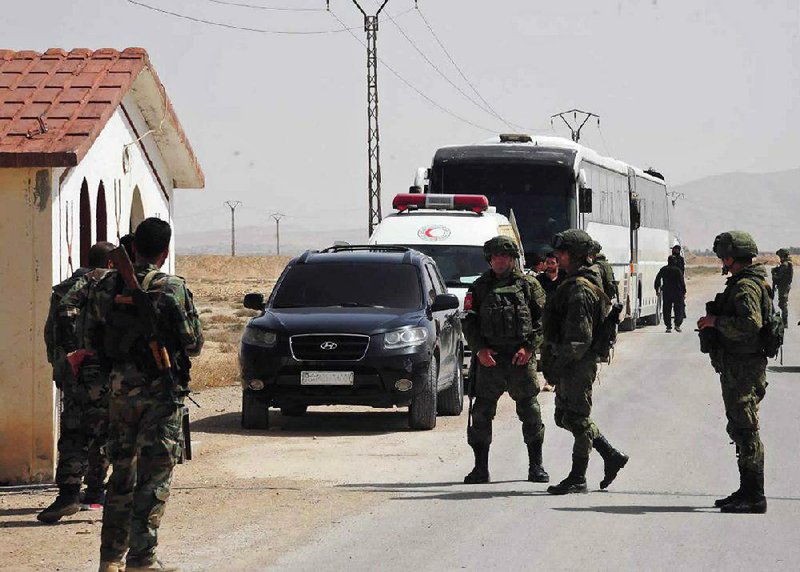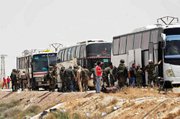WASHINGTON -- The Pentagon said Thursday that a "preponderance of the evidence" indicates there were chemical weapons, including "elements" of sarin nerve gas, at the three Syrian sites attacked by the U.S. and its allies last week.
Marine Lt. Gen. Kenneth McKenzie said at a Pentagon briefing that the United States believes the Syrian government, six days after the strikes, can still mount "limited attacks" but that its ability to conduct research or improve chemical weapons has been degraded. He said its remaining chemical capabilities are "probably spread throughout the country at a variety of sites."
McKenzie said that if Syrian forces were considering possible future attacks, "they've got to look over their shoulder and be worried that we're looking at them, and we'll have the ability to strike them again."
The American assessment underscored the difficulty in getting additional or more conclusive evidence about the Syrians' suspected use of chemical weapons and verifying the allies' success in destroying any large caches of chlorine gas or sarin.
"We believe the absolute preponderance of the evidence is that there were chemical weapons" at the targeted sites, including "elements of sarin particularly" at the Barzah research and development center in the Damascus area, said McKenzie, director of the Joint Chiefs of Staff. That was the mostly heavily attacked of the three sites targeted in the missile barrage.
McKenzie said it was unlikely that the U.S. or allies would gain much access to the sites where the Syrian government reportedly conducted chemical attacks on its own people.
The U.S. and France say they have evidence that poison gas was used in Douma, east of the capital, where dozens of people died, and that President Bashar Assad's military was behind it, but the two countries have not made that evidence public. Syria and its ally Russia deny any such attack took place.
McKenzie said plume analysis from the allies' missile strikes and the lack of civilian casualties in the area suggest that no chemical gas escaped into the atmosphere during the strikes that hit their targets in Syria early Saturday.
The U.S. military has said there was "probably" chlorine and "possibly" sarin at "possibly" all the sites.
Pentagon spokesman Dana White said there are no indications Syria is preparing to use chemical weapons again, and there have been no reports of civilian casualties from the allied missile strikes.
McKenzie was asked about reports that the Syrians had turned two unexploded cruise missiles over to the Russians. He said he hadn't heard anything about that.
The strike of 105 missiles targeted three sites -- suspected chemical weapons storage and research facilities near Damascus and Homs. The attack lasted roughly two minutes.
Trump announced the attack last Friday night in Washington as the missiles were hitting Syria before dawn Saturday.
Hours later, Trump said on Twitter that the strikes "could not have had a better result."
"Mission Accomplished!" Trump declared on Twitter.
In an assessment of the attack, the Pentagon indicates that the Barzah center in Damascus was destroyed, according to a U.S. intelligence analyst who saw the report and described it to The New York Times on the condition of anonymity.
The Western allies believed that the Assad government was rebuilding its chemical weapons program out of that facility. It has been closely monitored since the Organization for the Prohibition of Chemical Weapons found precursors for nerve agents there in 2014.
The other two sites -- the Him Shinshar chemical weapons bunker and storage facility in Homs -- were severely damaged. But the analyst said the report cited surveillance assets that watched a 5-ton truck leave one of those sites the day before it was struck, with a tarp-covered load that could have included equipment or chemical weapons.
Military experts voiced skepticism that the airstrikes severely hobbled Assad's chemical weapons program.
Claims that the attacks set it back years depend in part on what was inside Barzah at the time of the strikes, said Jeffrey Lewis, an analyst at the Center for Nonproliferation Studies at the Middlebury Institute of International Studies.
"That might be true if Barzah was filled with difficult-to-replace equipment or if crucial personnel were killed in the strike," he said. "But what we see is just a building. Are we certain all the important bits were aboveground and destroyed in the airstrike?"
REBELS ABANDON TOWN
The Syrian government on Thursday took control of a town northeast of Damascus after rebels there evacuated to north Syria -- the latest in a string of handovers by rebels to the government.
Residents in the town of Dumayr welcomed security forces into their town in a triumphant show for the cameras of the state-affiliated al-Ikhbariya TV station.
Waving the national flag, they lifted al-Ikhbariya TV correspondent Rabieh Dibeh onto their shoulders and chanted their support for Assad, after the last of 5,000 rebels and family members boarded buses and left the town.
There have been several handovers by rebels to the government in the capital region after a punishing government offensive against the rebellious eastern Ghouta region earlier this year.
More than 1,500 civilians were killed in the offensive, culminating in the alleged chemical weapons attack in Douma, where more than 40 people were reported killed.
[THE ISLAMIC STATE: Timeline of group’s rise, fall; details on campaign to fight it]
Rebels surrendered towns across eastern Ghouta as the offensive drove on, giving up control of an area once home to an estimated 400,000 people in a matter of weeks.
The Army of Islam rebels in Dumayr followed their companions belonging to the same group from Douma to Jarablus, a town in north Syria shared between Turkish and Syrian opposition control.
The Syrian government has been following a proven strategy of besieging opposition areas until residents and fighters, desperate for food, medical treatment and relief, give up and accept government control.
A similar arrangement to have Islamic State militants evacuate their pocket inside the capital appeared to collapse Thursday.
Government forces began bombarding the Hajr al-Aswad neighborhood and Yarmouk Palestinian camp inside Damascus only hours after reports surfaced that Islamic State militants would be given two days to leave.
Opposition activist Sami Dreid, in the nearby Yalda neighborhood, said the militants were expected to relocate to Islamic State-held territory in the east Syrian desert. He said it was not clear why the deal appeared to have fallen through.
Dumayr, in the Qalamoun mountains, is a short drive away from Douma.
WAR ON ISIS STALLS
The U.S.-led campaign to eliminate the Islamic State from Syria, meanwhile, has stalled.
The U.S. has 2,000 troops in Syria assisting Arab and Kurdish fighters against the Islamic State, even as Trump resists deeper U.S. involvement and is eager to withdraw completely in coming months. The president wants "other people" to deal with Syria, whose civil war has spawned the greatest humanitarian crisis since World War II in terms of refugees.
It is unclear if Trump will go ahead with a total U.S. withdrawal while the Islamic State, sometimes referred to by the acronym ISIS, retains even a small presence in Syria.
Since January, when Trump asserted in his State of the Union address that "very close to 100 percent" of Islamic State territory in Syria and Iraq had been liberated, progress toward extinguishing the extremists' caliphate, or self-proclaimed state, has ground to a halt and shows no sign of restarting.
U.S. warplanes continue to periodically bomb remaining pockets of the Islamic State in eastern Syria, but ground operations by U.S. partner forces have slowed.
"We've halted forward progress and are essentially attempting to avoid losing territory we've gained to date," said Jennifer Cafarella, an analyst at the Institute for the Study of War. She said she sees two potential solutions: send additional U.S. combat power to eastern Syria to take on the Islamic State more directly, or resolve a diplomatic dispute with Turkey that has largely sidelined the main U.S. military partner in Syria, the Syrian Democratic Forces.
Now that Trump has upped the ante by attacking Syria directly for the second time in just over a year, Cafarella said in an interview this week, it is possible that Syria and its two main international supporters -- Russia and Iran -- will retaliate militarily against American forces and their Kurdish and Arab partners in eastern Syria "in an attempt to compel an American withdrawal by raising the cost of continued American involvement."
The U.S. last launched strikes against Syria in April 2017, also in response to reports of a chemical-weapons attack.
The Trump administration has been saying in recent months that 98 percent of Islamic State territory has been liberated, suggesting the campaign was close to final victory, although on April 3 the Army general overseeing the campaign, Joseph Votel, put it differently, saying "well over 90 percent" of the caliphate had been retaken.
Information for this article was contributed by Lolita C. Baldor, Philip Issa and Robert Burns of The Associated Press and by Thomas Gibbons-Neff of The New York Times.
A Section on 04/20/2018

